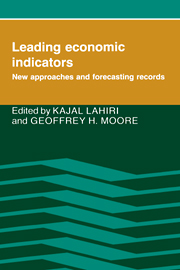Book contents
- Frontmatter
- Contents
- Preface
- List of contributors
- 1 Introduction
- PART I NEW CONCEPTS AND METHODS
- PART II FORECASTING RECORDS AND METHODS OF EVALUATION
- 9 Forecasting cyclical turning points: The record in the past three recessions
- 10 Turning point predictions, errors, and forecasting procedures
- 11 Forecasting peaks and troughs in the business cycle: On the choice and use of appropriate leading indicator series
- 12 Using a consensus of leading economic indicators to find the right ball park for real GNP forecasts
- 13 Some Australian experience with leading economic indicators
- 14 Turning point prediction with the composite leading index: An ex ante analysis
- 15 Forecasting recessions under the Gramm-Rudman-Hollings law
- 16 Leading indicators of inflation
- PART III NEW ECONOMIC INDICATORS
- Index
10 - Turning point predictions, errors, and forecasting procedures
Published online by Cambridge University Press: 05 June 2012
- Frontmatter
- Contents
- Preface
- List of contributors
- 1 Introduction
- PART I NEW CONCEPTS AND METHODS
- PART II FORECASTING RECORDS AND METHODS OF EVALUATION
- 9 Forecasting cyclical turning points: The record in the past three recessions
- 10 Turning point predictions, errors, and forecasting procedures
- 11 Forecasting peaks and troughs in the business cycle: On the choice and use of appropriate leading indicator series
- 12 Using a consensus of leading economic indicators to find the right ball park for real GNP forecasts
- 13 Some Australian experience with leading economic indicators
- 14 Turning point prediction with the composite leading index: An ex ante analysis
- 15 Forecasting recessions under the Gramm-Rudman-Hollings law
- 16 Leading indicators of inflation
- PART III NEW ECONOMIC INDICATORS
- Index
Summary
It has long been recognized that there is something special about cyclical turning points and the predictions that are associated with these turns. It has been argued that the procedures for making quantitative forecasts, which are usually derived from minimum mean square error linear prediction theory, are not appropriate for making turning point predictions (Samuelson, 1976; Wecker, 1979). Since the process of detecting changes in regimes is different from making quantitative predictions, forecasting methods designed exclusively to recognize and predict turning points have been developed. These alternative methods, specifically designed for predicting turning points, include individual leading series, indexes of leading series, and rate of change methods.
Yet the problem remains: How do you determine whether a set of quantitative forecasts did or did not predict the onset or end of a recession? This chapter will explore this and related problems. The first section will review the criteria for identifying turning points when indicators are used. Then we will consider the difficulties that may be encountered if one has to determine whether quantitative forecasts predicted turns. The forecast record in the vicinity of turning points will be considered, and hypotheses to explain why the observed errors occurred will be advanced. Finally, there will be suggestions for improving forecasting performance.
Turning point predictions with indicators
Calling a turn
In analyzing the forecasting record of an indicator, it is necessary to develop rules for identifying turning points in the predictor.
- Type
- Chapter
- Information
- Leading Economic IndicatorsNew Approaches and Forecasting Records, pp. 169 - 182Publisher: Cambridge University PressPrint publication year: 1991
- 5
- Cited by



